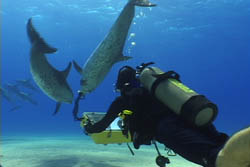
DATE SET TO DECIDE HUMPBACKS' FATE
The International Whaling Commission has set Dec. 8 - 10 in St. Petersburg, Florida, USA for a meeting that will decide whether Greenland will receive a quota to kill 50 humpback whales. BlueVoice opposes this quota in the strongest terms. Most people are not aware of this impending slaughter. We are distributing flyers suggesting ways to protest the hunt on whale watching boats around the United States and will soon begin efforts to get state governors to declare humpbacks animals of high cultural and economic importance to their coastal towns. To help us distribute flyers email us at contact@bluevoice.org.
Humpback whales are large brained, highly communicative sentient creatures. We must make the oceans safe for such magnificent creatures.
Hardy Jones

